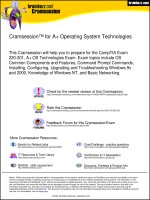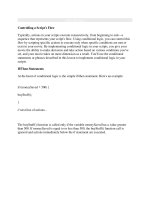Tài liệu Creating a Windows Forms Application docx
Bạn đang xem bản rút gọn của tài liệu. Xem và tải ngay bản đầy đủ của tài liệu tại đây (31.67 KB, 8 trang )
Creating a Windows Forms Application
So far you have used Visual Studio 2005 to create and run a basic Console application.
The Visual Studio 2005 programming environment also contains everything you'll need
to create graphical Windows applications. You can design the form-based user interface
of a Windows application interactively by using the Visual Designer. Visual Studio 2005
then generates the program statements to implement the user interface you've designed.
From this explanation, it follows that Visual Studio 2005 allows you to maintain two
views of the application: the Design View and the Code View. The Code and Text Editor
window (showing the program statements) doubles as the Design View window
(allowing you to lay out your user interface), and you can switch between the two views
whenever you want.
In the following set of exercises, you'll learn how to create a Windows program in Visual
Studio 2005. This program will display a simple form containing a text box where you
can enter your name and a button that, when clicked, displays a personalized greeting in a
message box. You will use the Visual Designer to create your user interface by placing
controls on a form; inspect the code generated by Visual Studio 2005; use the Visual
Designer to change the control properties; use the Visual Designer to resize the form;
write the code to respond to a button click; and run your first Windows program.
Create a Windows project in Visual Studio 2005
1. On the File menu, point to New, and then click Project. The New Project dialog
box opens.
2. In the Project Types pane, click Visual C#.
3. In the Templates pane, click the Windows Application icon.
4. Ensure that the Location field refers to your \My Documents\Visual CSharp Step
by Step\Chapter 1 folder.
5. In the Name field, type WinFormHello.
6. In the Solutions field, ensure that Create new Solution is selected. This action
creates a new solution for holding the Windows application. The alternative, Add
to Solution, will add the project to the TextHello solution.
7. Click OK. Visual Studio 2005 closes your current application (prompting you to
save it first of necessary) and creates and displays an empty Windows form in the
Design View window.
In the following exercise, you'll use the Visual Designer to add three controls to the
Windows form and examine some of the C# code automatically generated by Visual
Studio 2005 to implement these controls.
Create the user interface
1. Click the Toolbox tab that appears to the left of the form in the Design View. The
Toolbox appears, partially obscuring the form and displaying the various
components and controls that you can place on a Windows form.
2. In the Toolbox, click the + sign by Common Controls to display a list of controls
that are used by most Windows Forms applications.
3. Click Label, and then click the visible part of the form. A Label control is added to
the form, and the Toolbox disappears from view.
TIP
If you want the Toolbox to remain visible but not hide any part of the form, click
the Auto Hide button to the right in Toolbox title bar (it looks like a pin). The
Toolbox appears permanently on the left side of the Visual Studio 2005 window,
and the Design View shrinks to accommodate it. (You might lose a lot of space if
you have a low-resolution screen.) Clicking the Auto Hide button once more
causes the Toolbox to disappear again.
4. The Label control on the form is probably not exactly where you want it. You can
click and drag the controls you have added to a form to reposition them. Using this
technique, move the Label control so that it is positioned towards the upper-left
corner of the form. (The exact placement is not critical for this application.)
5. On the View menu, click Properties Window. The Properties window appears on
the right side of the screen. The Properties window allows you to set the properties
for items in a project. It is context sensitive, in that it displays the properties for
the currently selected item. If you click anywhere on the form displayed in the
Design View, you will see that the Properties windows displays the properties for
the form itself. If you click the Label control, the window displays the properties
for the label instead.
6. Click the Label control on the form. In the Properties window, locate the Text
property, change it from label1 to Enter your name, and then press Enter. On the
form, the label's text changes to Enter Your Name.
TIP
By default, the properties are displayed in categories. If you prefer to display the
properties in alphabetical order, click the Alphabetical button that appears above
the properties list.
7. Display the Toolbox again. Click TextBox, and then click the form. A TextBox
control is added to the form. Move the TextBox control so that it is directly
underneath the Label control.
TIP
When you drag a control on a form, alignment handles appear automatically when
the control becomes aligned vertically or horizontally with other controls. This
give you a quick visual cue for making sure that controls are lined up neatly.
8. While the TextBox control is selected, locate the Text property in the Properties
window, type here, and then press Enter. On the form, the word here appears in
the text box.
9. In the Properties window, find the (Name) property. Visual Studio 2005 gives
controls and forms default names, which, although they are a good starting point,
are not always very meaningful. Change the name of the TextBox control to
userName.
NOTE
We will talk more about naming conventions for controls and variables in Chapter
2, “Working with Variables, Operators, and Expressions.”
10. Display the Toolbox again, click Button, and then click the form. Drag the Button
control to the right of the TextBox control on the form so that it is aligned
horizontally with the text box.
11. Using the Properties window, change the Text property of the Button control to
OK. Change its (Name) property to ok. The caption on the button changes.
12. Click the Form1 form in the Design View window. Notice that resize handles
(small squares) appear on the lower edge, the right-hand edge, and the right-hand
bottom corner of the form.
13. Move the mouse pointer over the resize handle. The pointer changes to a diagonal
double-headed arrow.
14. Hold down the left mouse button, and drag the pointer to resize the form. Stop
dragging and release the mouse button when the spacing around the controls is
roughly equal.
TIP
You can resize many controls on a form by selecting the control and dragging one
of the resize handles that appears in the corners of the control. Note that a form
has only one resize handle, whereas most controls have four (one on each corner).
On a form, any resize handles other than the one in the lower-right corner would
be superfluous. Also note that some controls, such as Label controls, are
automatically sized based on their contents and cannot be resized by dragging
them.
The form should now look similar to the one in the following graphic.
15. In the Solution Explorer, right-click the file Form1.cs, and then click View Code.
The Form1.cs source file appears in the Code and Text Editor window.
There are now two tabs named Form1.cs above the Code and Text Editor/Design
View window. You can click the one suffixed with [Design] to return to Design
View window at any time.
Form1.cs contains some of the code automatically generated by Visual Studio
2005. You should note the following elements:
o
using directives
Visual Studio 2005 has written a number of using directives at the top of
the source file (more than for the previous example). For example:
using System.Windows.Forms;
The additional namespaces contain the classes and controls used when
building graphical applications—for example, the TextBox, Label, and
Button classes.
o
The namespace
Visual Studio 2005 has used the name of the project as the name of the top-
level namespace:
namespace WinFormHello
{
...
}
o
A class
Visual Studio 2005 has written a class called Form1 inside the WinForm
Hello namespace:
namespace WinFormHello
{
partial class Form1 ...
{
...
}
}
NOTE
For the time being, ignore the partial keyword in this class. I will describe
its purpose shortly.
This class implements the form you created in the Design View. (Classes
are discussed in Chapter 7.)
There does not appear to be much else in this class—there is a little bit of
code known as a constructor that calls a method called
InitializeComponent, but nothing else. (A constructor is a special method
with the same name as the class. It is executed when the form is created and
can contain code to initialize the form. Constructors are also discussed in
Chapter 7.) However, Visual Studio 2005 is performing a sleight of hand
and is hiding a few things from you, as I will now demonstrate.
In a Windows Forms application, Visual Studio 2005 actually generates a
potentially large amount of code. This code performs operations such as
creating and displaying the form when the application starts, and creating
and positioning the various controls on the form. However, this code can
change as you add controls to a form and change their properties. You are
not expected to change this code (indeed, any changes you make are likely
to be overwritten the next time you edit the form in the Design View), so
Visual Studio 2005 hides it from you.
To display the hidden code, return to the Solution Explorer, and click the
Show All Files button. The bin and obj folders appear, much as they did
with the Console application you developed in the first part of this chapter.
However, notice that Form1.cs now has a + sign next to it. If you click this
+ sign, you see a file called Form1.Designer.cs, and a file called
Form1.resx.
Double-click the file Form1.Designer.cs to display its contents in the Code
and Text Editor window. You will see the remaining code for the Form1
class in this file. C# allows you to split the code for a class across multiple
source files, as long as each part of the class is marked with the partial
keyword. This file includes a region labelled Windows Form Designer
generated code. Expanding this region by clicking the + sign reveals the









